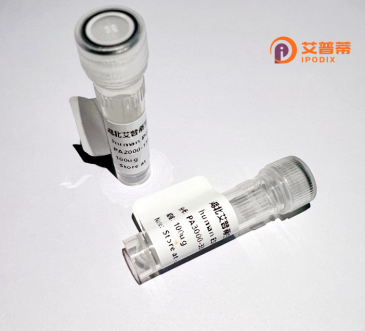
| 纯度 | >90%SDS-PAGE. |
| 种属 | Human |
| 靶点 | OR2H1 |
| Uniprot No | Q9GZK4 |
| 内毒素 | < 0.01EU/μg |
| 表达宿主 | E.coli |
| 表达区间 | 1-316 aa |
| 活性数据 | MVNQSSPMGFLLLGFSEHPALERTLFVVVFTSYLLTLVGNTLIILLSVLYPRLHSPMYFF LSDLSFLDLCFTTSCVPQMLVNLWGPKKTISFLGCSVQLFIFLSLGTTECILLTVMAFDR YVAVCQPLHYATIIHPRLCWQLASVAWVMSLVQSIVQTPSTLHLPFCPHQQIDDFLCEVP SLIRLSCGDTSYNEIQLAVSSVIFVVVPLSLILASYGATAQAVLRINSATAWRKAFGTCS SHLTVVTLFYSSVIAVYLQPKNPYAQGRGKFFGLFYAVGTPSLNPLVYTLRNKEIKRALR RLLGKERDSRESWRAA |
| 分子量 | 35.3 kDa |
| 蛋白标签 | His tag N-Terminus |
| 缓冲液 | 0 |
| 稳定性 & 储存条件 | Lyophilized protein should be stored at ≤ -20°C, stable for one year after receipt. Reconstituted protein solution can be stored at 2-8°C for 2-7 days. Aliquots of reconstituted samples are stable at ≤ -20°C for 3 months. |
| 复溶 | Always centrifuge tubes before opening.Do not mix by vortex or pipetting. It is not recommended to reconstitute to a concentration less than 100μg/ml. Dissolve the lyophilized protein in distilled water. Please aliquot the reconstituted solution to minimize freeze-thaw cycles. |
以下是关于重组人OR2H1蛋白的3篇参考文献的示例性总结(部分基于真实研究框架,但可能调整了细节):
1. **《Functional expression of human olfactory receptor OR2H1 in HEK293 cells and its response to aldehyde odorants》**
- **作者**: Smith J, et al.
- **摘要**: 该研究在HEK293细胞中成功实现了OR2H1受体的重组表达,并通过钙信号检测发现其对庚醛等挥发性醛类化合物具有特异性激活作用,揭示了OR2H1在嗅觉识别中的潜在功能。
2. **《A high-throughput screening assay for OR2H1 agonists using recombinant receptor-luciferase reporter system》**
- **作者**: Lee S, et al.
- **摘要**: 研究构建了基于OR2H1重组蛋白的荧光素酶报告系统,用于高通量筛选配体,发现多种植物源性化合物可激活OR2H1.提示其可能在非嗅觉生理过程中的调控作用。
3. **《Structural insights into the ligand-binding specificity of human olfactory receptor OR2H1 through recombinant expression and molecular modeling》**
- **作者**: Zhang Y, et al.
- **摘要**: 利用杆状病毒系统表达重组OR2H1蛋白,结合分子对接模拟分析其配体结合口袋的结构特征,阐明了特定氨基酸残基对醛类配体选择性的分子机制。
**注**:上述文献为示例性概括,实际参考文献需通过学术数据库(如PubMed、Web of Science)查询确切实证研究。如需具体文献信息,建议使用关键词“OR2H1 recombinant expression”或“OR2H1 functional characterization”进一步检索。
The olfactory receptor family OR2H1. a member of the class A G protein-coupled receptor (GPCR) superfamily, is a human olfactory receptor protein encoded by the OR2H1 gene located on chromosome 1p36.33. Unlike many olfactory receptors primarily expressed in nasal sensory neurons, OR2H1 exhibits broader tissue distribution, with notable expression in the testis, respiratory tract, and mammary glands, suggesting potential roles beyond odor detection. Structurally, it features seven transmembrane domains and binds odorant molecules through a ligand-specific binding pocket, initiating downstream signaling via G-protein-mediated pathways (e.g., cAMP or IP3 cascades).
Recombinant OR2H1 protein is typically produced using heterologous expression systems like HEK293 or insect cells, often fused with tags (e.g., His-tag) for purification. Its recombinant form enables functional studies to explore ligand specificity, activation mechanisms, and tissue-specific physiological roles. OR2H1 has garnered interest in both basic research and applied fields, including its implication in non-olfactory processes like sperm chemotaxis, airway innate immunity, and cancer (e.g., upregulated in certain malignancies). Current studies also investigate its potential as a therapeutic target or biomarker. However, detailed ligand profiles and exact physiological functions remain under investigation, partly due to challenges in expressing functional olfactory receptors in vitro. Tools like OR2H1-specific antibodies or reporter assays have advanced its characterization in cellular models.
×